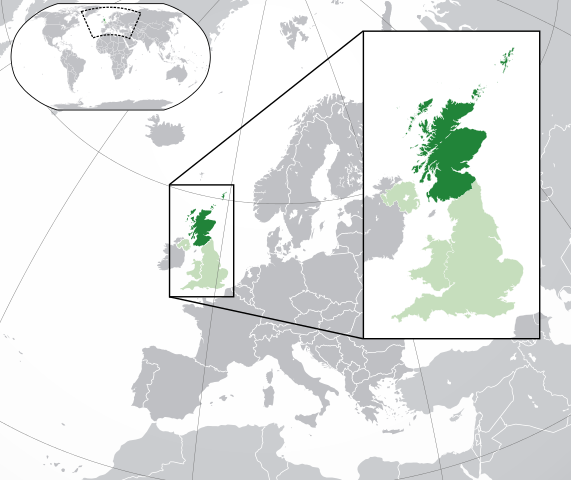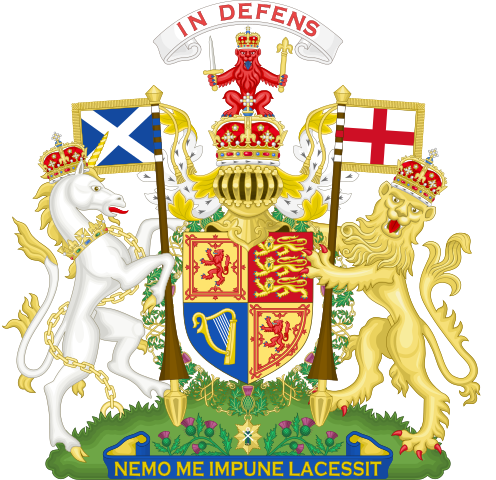More languages
More actions
| Scotland Alba | |
|---|---|
 | |
| Capital | Edinburgh |
| Largest city | Glasgow |
| Leaders | |
• Monarch | Charles III |
• First Minister | John Swinney |
| Legislature | Scottish Parliament |
| Area | |
• Total | 80,231 km² |
| Population | |
• 2022 estimate | 5,436,600 |
Scotland is a constituent country of the United Kingdom occupying the northern part of the island of Britain. Scotland is semi-autonomous, and has its own parliament but the British Parliament has supremacy over the Scottish.[1] There are high levels of support for independence in Scotland but the British Government refuses to allow an independence referendum after the referendum in 2014 failed.[2]
History
Kingdom of Scotland 843-1707
See main article: Kingdom of Scotland (843-1707)
Union of the Crowns
Following the death of English Queen Elizabeth I in 1603, the English throne passed to King James VI of Scotland making him King James I of England. Although Scotland would remain officially independent for another 100 years they were effectively united with the English under the Stuart monarchy with the Scottish Kings preferring to reside in England over Scotland.[3]
Following the Scottish Governments failed Darian Scheme, an attempt at colonisation in Panama, Scotland was almost bankrupted. The crippled Scottish economy was a factor which contributed towards the dissolution of the Scottish Parliament, and the subsequent union with England. In 1707 the Act of Union officially united the Kingdoms of Scotland, and England forming the Kingdom of Great Britain, effectively it was an annexation of Scotland by England.[4]
Jacobite Rebellions
In 1688 catholic King James II of England, (James VII of Scotland) was ousted by a bourgeois revolution and replaced by protestant Dutch King William III of Orange. The deposed king fled to France, and over the next few years there were several unsuccessful skirmishes between the English, and the supporters of James II (Jacobites).[5]
In 1701 James II died, and French King Louis XIV recognised his son James III as King James VIII of Scotland. In September 1715 a Jacobite uprising began leading to a few failed battles with English troops, before James III fled back to France in February 1716, and Jacobite troops disbanded.[5]
In July 1745 Prince Charles Stuart, son of James III, landed in Scotland to began the last Jacobite rebellion, claiming the throne for his father. Jacobite forces reached as far south as Derby before being forced to retreat to wait for French reinforcements that never materialised. The rebellion ended with the battle of Culloden, a catastrophic defeat for the Jacobites, following which Charles fled back to France in June 1746. The house of Stuart would remain in exile in France until the death of Henry Stuart in 1807 ending the male Stuart line.[5]
Following the failed Jacobite rebellion, the British Whig government under Henry Pelham set about destroying the Highlander culture and way of life, using methods such as outlawing tartan and replacing Gaelic with English as the language of government. Over the next century Highland clearances forcibly removed the native population from their land in a campaign of ethnic cleansing with the former occupants often emigrating to the Americas. Clearances continued into the 19th Century with potato famines exasperating the rate of highlanders forced to emigrate due to their land being stolen.[6]
21st Century
In 2014 an independence referendum on Scottish Independence was held resulting in a rejection by 55.3% of the population.[7] However, in the following years the desire for independence has only grown, especially since the 2016 Brexit referendum in which 62% of Scots voted to remain in the EU against the wishes of the UK.[2]
Colonialism
Nova Scotia
In 1621 Earl William Alexander, was granted a charter by King James VI of Scotland to colonise New Scotland also known as Nova Scotia, a region on the east coast of modern day Canada rightfully belonging to the Mi'kma'ki nation. This land was organised into large areas of land, which could be purchased by rich Scots to name themself a Baron of Nova Scotia, in order to entice settlers to invest. In 1622 the first settlers landed in the region and settled Port Royal but due to lack of skills and supplies many soon died of sickness or returned home. In 1629 William Alexander, son of Earl William Alexander, brought 70 colonists to Port Royal in order to bolster the struggling colony, and constructed Fort Charles.[8]
However, the ongoing Anglo-French War caused the colony to struggle due to supply issues and French attacks forcing many settlers to flee, and in 1632 the land was returned to France forcing the colony to be abandoned. Eventually the territory returned to English control, and with Scotland having been annexed by English in 1707, many Scots decided to begin emigrating to Nova Scotia again, especially after the failed Jacobin rebellion, leading to a large Scottish minority in modern day Nova Scotia.[8]
Darien Scheme
In 1693, William Paterson helped to set up the Company of Scotland Trading to Africa and the Indies to establish an entrepôt on the Isthmus of Darien in modern day Panama. Although originally financed by a mixture of Scottish, English, and Dutch investors, pressure from the East India Company caused the English and Dutch to withdraw leaving the Scottish as the sole investors. Thousands of ordinary Scottish people invested in the project in hope of a better life and prosperity and overall around half of the national capital ended up being invested.[4]
On 12 July 1698 ships carrying 1,200 people set sail for the Americas, but by the time they arrived at their destination on 30 October 1698 many had already died and a great deal others were sick. Their struggles only continued in the land they called Caledonia due to lack of food, and attacks from the hostile Spanish. The native population took pity on them and brought them gifts of food but even so in 7 months, 400 were dead and the rest were weak or struggling with yellow fever.[4]
The decision was made to abandon the project but lack of communication with mainland Scotland meant that in November 1699, 1,300 more settlers set off for the new world with another fleet sailing soon after. Only one ship returned out of the total of sixteen that had originally sailed carrying few survivors. Over 2,000 lives were lost in this scheme, and along with the bankrupted economy caused by the loss of investment, Scotland was soon after forced into a union with England.[4]
Politics
The Scottish Parliament and Government were established in 1999, and have control over matters of health, education, justice, police, fire services, and housing in Scotland. There are 129 Members of the Scottish Parliament (MSPs) elected by a bourgeois democratic system of proportional representation known as the Additional Member System. The political party with the most MSPs forms the government with one MSP being elected First Minister, the head of the Scottish Government.[1]
References
- ↑ 1.0 1.1 "What's the difference between the Scottish Parliament and the Scottish Government?" (2023). Scottish Parliament.
- ↑ 2.0 2.1 Libby Brooks (2020-12-25). "Now Brexit is sealed, Scotland plunges into battle for the narrative" The Guardian.
- ↑ Neil Faulkner (2013). A Marxist History of the World: From Neanderthals to Neoliberals: 'The First Wave of Bourgeois Revolutions'. [PDF] Pluto Press. ISBN 9781849648639 [LG]
- ↑ 4.0 4.1 4.2 4.3 Ben Johnson (2024). "The Darien Scheme" Historic UK.
- ↑ 5.0 5.1 5.2 "Jacobite timeline of key events" (2024). The National Archives.
- ↑ "Scotland Back in the Day: How the brutal atrocities of the Highland Clearances changed Scotland forever" (2016-07-19). The National.
- ↑ "Scottish independence referendum: final results in full" (2014-09-18). The Guardian.
- ↑ 8.0 8.1 Henry Whitelaw (2017-02-13). "The Scottish Colonisation of Nova Scotia" Historic UK.


